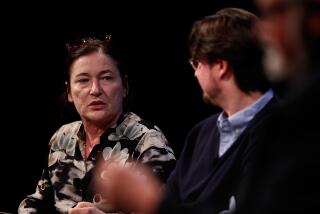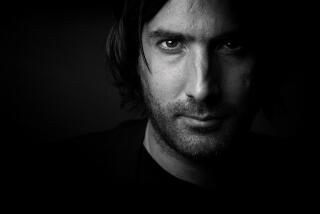Book review: ‘Bring Up the Bodies’ is a compelling re-creation
Bring Up the Bodies
A Novel
Hilary Mantel
Henry Holt: 432 pp., $28
Hilary Mantel’s novel about the Tudor political puppet-master supremo Thomas Cromwell, “Wolf Hall,” winner of the 2009 Man Booker Prize for fiction, was so richly packed with character and action that it was bound to burst its banks. Originally intended to take Cromwell through the four years that it took him to fall from the pinnacle of power (where we left him at the end of “Wolf Hall”) to his own appointment with the executioner’s ax, “Bring Up the Bodies” forms the middle volume of what is to be a trilogy.
The good news is that it is more than the equal of its predecessor when it comes to intensity and drama, its portrait of Cromwell ever more evocative and nuanced as he disposes of a queen, more elevated than a mere cardinal (Wolsey) and saint (Thomas More), whose downfalls were front and center in “Wolf Hall.” The shadow that hangs ever so subtly over “Bring Up the Bodies” is that in Cromwell’s masterly transformation of Anne Boleyn from Henry VIII’s crowned consort to a headless body in the Tower of London, he may, for all his devious triumph in bringing off such a coup, finally have bitten off more than even he will be able to chew.
Such shadings are key to the effectiveness of Mantel’s fictive re-creation of the vicious world of intrigue and mortal danger that was the court of Henry VIII, where one queen (Katherine of Aragon) can be cast aside for another, who in turn is disposed of still more summarily and brutally. It is a world where literally all bets are off and Cromwell is free to move real live people as coldly and calculatingly as if they really are chess pieces:
“Thomas More, in his room in the Tower, had said to him, ‘Where will you strike next, Cromwell? You are going to pull all England down.’ He had said, I pray to God, grant me life only as long as I use my power to build and not destroy.”
But of course the question recurring throughout this novel is what is he building, apart from his ever-expanding power base? Is there an underlying purpose, a master plan, behind all his Machiavellian maneuverings? Perhaps Mantel’s most remarkable achievement is to enlist just enough of the reader’s sympathy to empathize with Cromwell as they perch on his shoulder and at times even enter his mind — if not quite his soul — as he works his wiles on victims and those who can help him engineer their downfall.
Of course it helps that in Anne Boleyn he has such an unsympathetic foil, for if she was unpleasant as the simpering wily upstart determined to climb up the ladder in “Wolf Hall,” she is still more so now that she is crowned and anointed. The striking young woman whose unusual good looks and charms seduced the restless king is now a harried figure, frantic to give him the male heir he desires above all things. Rapidly aging, flesh melts away from her increasingly angular frame even during a pregnancy that cannot carry the male fetus to term. In her desperation, she is a real danger to her predecessor who is not dying expeditiously enough to suit her and still more so to Katherine and Henry’s daughter Mary, whom she perceives as a threat to her own child Elizabeth.
And, as he well knows, to Cromwell himself, who helped raise her high but can, she rightly suspects, be as effective in engineering her downfall. Not for nothing does Mantel have Cromwell juxtapose in his mind Anne’s clothes and jeweled adornments with very different images:
“The colours should have had a fresh maidenly charm; but all he could think of were stretched innards, umbles and tripes, grey-pink intestines looped out of a living body … slit up and galloched by the hangman.... The pearls around her long neck looked to him like beads of fat, and as she argued she would reach up and tug them; he kept his eyes on her fingertips, nails flashing like tiny knives.”
Only a little way into the book, this scene prefigures its end — that now bare neck fumbled at just before a terrible swift sword severs it, the torture and mayhem that brings about that coup and all the collateral damage (those eponymous bodies) necessary to achieve it. As anyone who has read “Wolf Hall” or Mantel’s extraordinary take on the French Revolution, “A Place of Greater Safety,” knows, her imagination has, in a suggestive phrase common in her native England but less so here, “something of the night” about it. That she has an affinity for what Queen Victoria called the “Schattenseite” — the shadow side of life — the dark realms of terror and the irrational, of sinister thoughts and the caustic actions they breed. “Bring Up the Bodies” provides plenty of scope for this aspect of her art.
With a sequel such as this, it is inevitable that the question must be asked: Does someone need to have read “Wolf Hall” to have a satisfactory experience with “Bring Up the Bodies”? Not really, although obviously those who have will feel a deeper understanding of how Cromwell came to be the force of nature he is.
But Mantel is so adept at referring here to his past, from the crucible of his childhood with an abusive father to the travels and travails that educated his mind and fired his ambition, that “Bring Up the Bodies” stands magnificently on its own. And such is her skill, her delicate touch, that for those who have read the earlier book, these references serve equally to remind, to reinforce her points. Whether you have read “Wolf Hall” or not, “Bring Up the Bodies” will make you long for that next one, which will complete — or will it? — Mantel’s Cromwell trilogy.
Rubin is the author of “Sarah Gertrude Millin: A South African Life.”
More to Read
The biggest entertainment stories
Get our big stories about Hollywood, film, television, music, arts, culture and more right in your inbox as soon as they publish.
You may occasionally receive promotional content from the Los Angeles Times.






